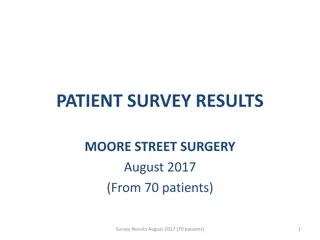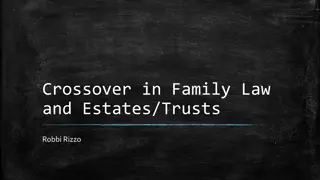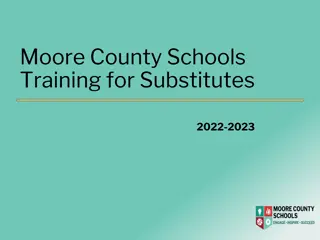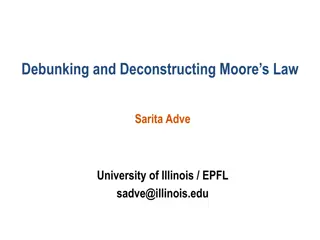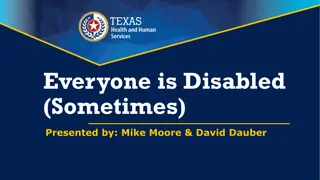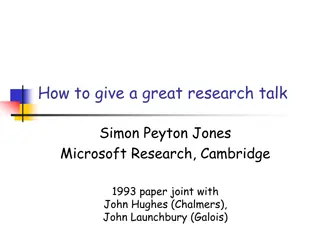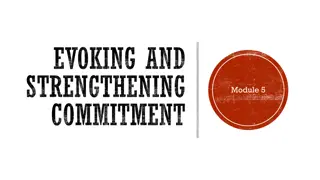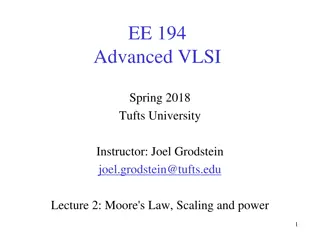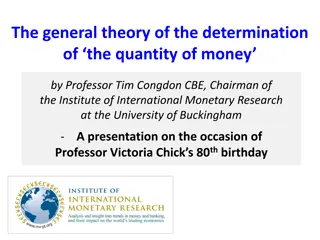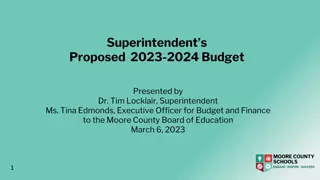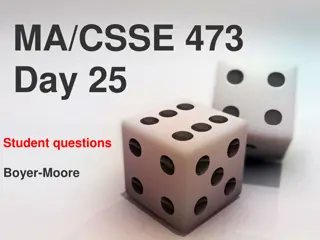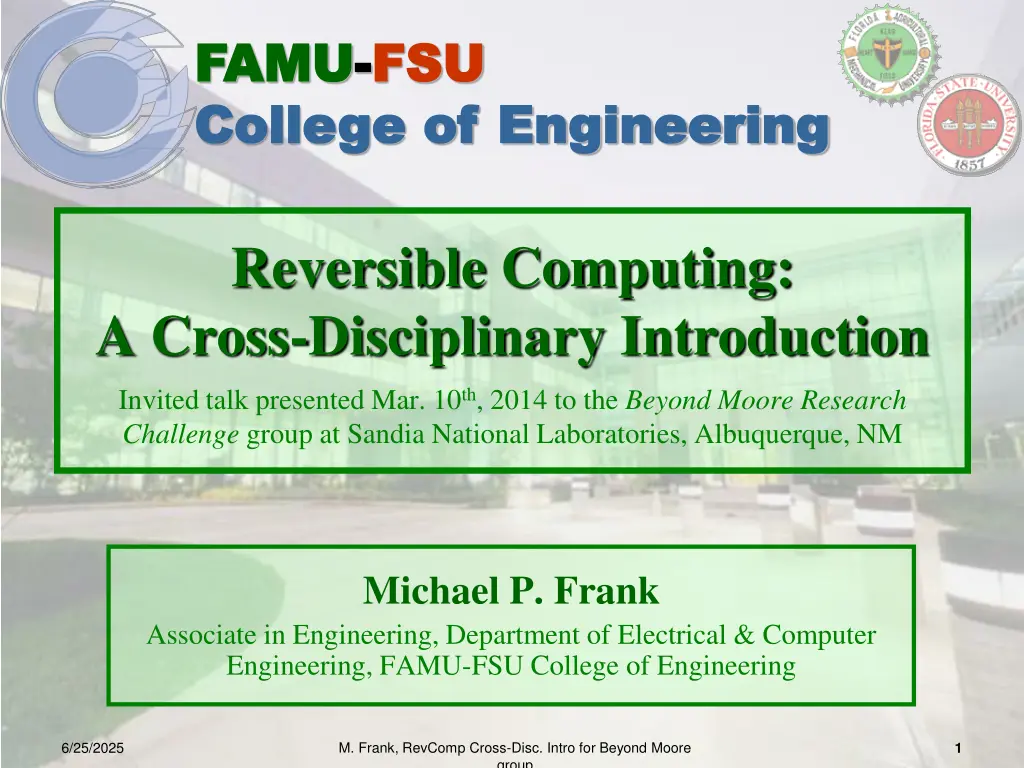
Reversible Computing: A Cross-Disciplinary Introduction
Explore the cutting-edge field of reversible computing and its potential to revolutionize digital technologies. Delve into the limitations of traditional CMOS scaling, the history of reversible computing research, and the challenges of energy efficiency scaling. Discover how a new mindset and collaboration across various disciplines are essential for overcoming these obstacles and unlocking the full potential of reversible computing.
Download Presentation

Please find below an Image/Link to download the presentation.
The content on the website is provided AS IS for your information and personal use only. It may not be sold, licensed, or shared on other websites without obtaining consent from the author. If you encounter any issues during the download, it is possible that the publisher has removed the file from their server.
You are allowed to download the files provided on this website for personal or commercial use, subject to the condition that they are used lawfully. All files are the property of their respective owners.
The content on the website is provided AS IS for your information and personal use only. It may not be sold, licensed, or shared on other websites without obtaining consent from the author.
E N D
Presentation Transcript
FAMU FAMU- -FSU College of Engineering College of Engineering FSU Reversible Computing: A Cross-Disciplinary Introduction Invited talk presented Mar. 10th, 2014 to the Beyond Moore Research Challenge group at Sandia National Laboratories, Albuquerque, NM Michael P. Frank Associate in Engineering, Department of Electrical & Computer Engineering, FAMU-FSU College of Engineering M. Frank, RevComp Cross-Disc. Intro for Beyond Moore group 6/25/2025 1
FAMU-FSU College of Engineering Outline of Talk Limits of traditional CMOS scaling And of all irreversible digital technologies Brief history of reversible computing research Review of some major developments An example reversible logic scheme: 2LAL RevComp s alternate path for power scaling Potential to sidestep limits of standard roadmap Requires cooperation, with a new mindset, among: Device physicists Process engineers Logic family designers / tool developers Circuit/interconnect designers Computer architects 6/25/2025 M. Frank, RevComp Cross-Disc. Intro for Beyond Moore group 2
FAMU-FSU College of Engineering Problems with continued CMOS power-performance scaling We have been aware these were coming for a long time! E.g., Proc. IEEE paper by David Frank & colleagues, 1997 Short-channel effects related to electron diffusion length Low thresholds hard to turn device off Even more fundamental limits on subthreshold slope of log(I)- log(VGS) curve ~60 mV/decade at best Limits Ion/Iofffor given logic swing Vdd 6/25/2025 M. Frank, RevComp Cross-Disc. Intro for Beyond Moore group 3
FAMU-FSU College of Engineering Even More Fundamental Problems with Energy Efficiency Scaling Boltzmann s Distribution tells us that any system experiences energy fluctuations of order ~kT Thus, reliably suppressing undesired transitions requires energy barriers/differences of 10s of kT If you dissipate say ~40 kT at any temperature T when switching, implies ~1 eV system dissip. into room-T env. Boltz. Dist. is derived by a totally general thermodynamic argument that is unaffected by the specific physical structure of the system in question Novel device physics cannot help (CNTs, optics, quantum) Fancy error correction codes cannot help Total energy/reliability of encoded bit still subject to argument! 6/25/2025 M. Frank, RevComp Cross-Disc. Intro for Beyond Moore group 4
FAMU-FSU College of Engineering An Absolute Requirement for Ongoing Power-Performance Scaling Given that we must, therefore, dissipate ~1 eV for each (irreversible, terrestrial) bit operation, We can only do at most ~6 1018 bit operations (6 Eops) per Joule of system energy dissipation Convert to FLOPS/W with your favorite conversion If we hope to ever do significantly better than this, we absolutely MUST start learning how to: Avoid Dissipating the Entire Bit Energy When Manipulating Bits! There literally is no other choice. 6/25/2025 M. Frank, RevComp Cross-Disc. Intro for Beyond Moore group 5
FAMU-FSU College of Engineering Brief History of Reversible Computing Research Rolf Landauer, 1961 Only irreversible (many-to-one) logical operations appear to require a fundamental minimum energy dissipation Charles Bennett, 1973 Irreversible operations are not required for universal computation Fredkin & Toffoli, late 70s Construct reversible computations by composing reversible logic primitives First proposal for an electronic reversible logic Seitz et al., Kollar & Athas, etc., 1980s Earliest development of quasi-adiabatic circuits in CMOS Younis & Knight & colleagues, 1990s First fully adiabatic sequential logic (early versions were still buggy) Bennett (1988), Lange et al. (1997), Frank & Ammer (1997) Exploring computational complexity overheads of reversible computing Frank & colleagues, 2000-2004 Development & simulation of a simple truly, fully adiabatic logic scheme (2LAL) 6/25/2025 M. Frank, RevComp Cross-Disc. Intro for Beyond Moore group 6
FAMU-FSU College of Engineering Von Neumann Landauer (VNL) Principle One correct statement of the principle: On average, oblivious erasure of a known logical bit must increase total entropy by at least k ln 2. Assuming 0 and 1 states arise equally often Can be proven true via a trivial argument: Fundamental physics is believed to be reversible Unitary quantum evolution is consistent with all data A many-to-one transformation of the logical state implies a one-to-many transformation of the detailed physical state. Increased entropy 6/25/2025 M. Frank, RevComp Cross-Disc. Intro for Beyond Moore group 7
FAMU-FSU College of Engineering Bennett s Insight Landauer: We can embed any irreversible (many-to-one) logical transformation into a larger reversible (one-to-one) transformation. However, this in general generates extra unwanted garbage bits what to do with them? Bennett: Just save the unwanted bits, reversibly copy the result, then undo the computation, de- computing the garbage. Frees up space for reuse in later computation. Space-inefficient, but later work greatly improved on this. 6/25/2025 M. Frank, RevComp Cross-Disc. Intro for Beyond Moore group 8
FAMU-FSU College of Engineering Adiabatic Logic using FETs: Basic Principle Basic recipe to transition a logic level with negligible dissipation ( adiabatically ): 1. Match levels between input node I and storage node S (with known data). 2. Switch voltage on transistor gate G to turn it on Can be done using same method, in staggered fashion. 3. Ramp voltage on input node I gradually to new logic level over some time t RC (R = eff. on-resistance) Dissipation ~CV2RC/t can be as small as desired Series/parallel combinations of devices can do logic CMOS can be used for full-swing transitions 4. Switch gate voltage on transistor to turn it off. G I S R C 6/25/2025 M. Frank, RevComp Cross-Disc. Intro for Beyond Moore group 9
FAMU-FSU College of Engineering Is there a fundamental lower limit to energy dissipation of adiabatic charging? No! C.f., Boechler et al. (APL 97:103502, 2010) measured dissipation for charging a capacitor through a resistor adiabatically Min. dissipation was much less than (kT ln 2), and was limited only by measurement uncertainty 6/25/2025 M. Frank, RevComp Cross-Disc. Intro for Beyond Moore group 10
2LAL: 2-level Adiabatic Logic A pipelined fully-adiabatic logic invented at UF (Spring 2000), implementable using ordinary CMOS transistors. TN T 2 Use simplified T-gate symbol: Basic buffer element: cross-coupled T-gates: need 8 transistors to buffer 1 dual-rail signal : 1 (implicit dual-rail encoding everywhere) in TP out 0 Animation: Tick # Only 4 timing signals 0-3 are needed. Only 4 ticks per cycle: i rises during ticks t i (mod 4) i falls during ticks t i+2 (mod 4) 0 1 2 3 0 1 2 3 6/25/2025 11
More Complex Logic Functions Non-inverting multi-input Boolean functions: 0 AND gate (plus delayed A) OR gate A0 A0 B0 A1 B0 (A B)1 (AB)1 One way to do inverting functions in pipelined logic is to use a quad-rail logic encoding: To invert, just swap the rails! Zero-transistor inverters. AN AP A = 0 A = 1 AN AP 6/25/2025 12
Shift Register Simulation Results (Cadence/Spectre) Power vs. freq., TSMC 0.18, Std. CMOS vs. 2LAL 2LAL = Two-level adiabatic logic (invented at UF, 00) Graph shows power dissipation vs. frequency in 8-stage shift register. At moderate frequencies (1 MHz), Reversible uses < 1/100th the power of irreversible! At ultra-low power (1 pW/transistor) Reversible is 100 faster than irreversible! Minimum energy dissip. per nFET is < 1 eV! 500 lower than best irreversible! 500 higher computational energy efficiency! Energy transferred is still ~10 fJ (~100 keV) So, energy recovery efficiency is 99.999%! Not including losses in power supply, though 1.E-05 1.E-06 Average power dissipation per nFET, W 1.E-07 Energy dissipated per nFET per cycle Standard CMOS 1.E-08 1.E-09 1.E-10 1.E-11 1.E-12 1.E-13 1.E-14 1.E+09 1.E+08 1.E+07 1.E+06 1.E+05 1.E+04 1.E+03 M. Frank, RevComp Cross-Disc. Intro for Beyond Moore group Frequency, Hz 13 6/25/2025
(log n)-time Recursive Adiabatic Wired-OR Carry-Skip Adder With this recursive structure, we can do a 2n-bit add in 2(n+1) (8 bit segment shown) logic levels. Cin S A B S A B S A B S A B S A B S A B S A B S A B Hardware overhead is < 2 regular ripple-carry! G Cin GCoutCin GCoutCin G Cin GCoutCin G Cin GCoutCin G Cin P P P P P P P P PmsGlsPls PmsGlsPls PmsGlsPls PmsGlsPls MS MS LS LS G G GCout Cin GCout Cin P P P P PmsGlsPls PmsGlsPls MS LS G GCout Cin P P PmsGlsPls LS GCout Cin P M. Frank, RevComp Cross-Disc. Intro for Beyond Moore group 14 6/25/2025
32-bit Adder Simulation Results Further improvements may be attainable through more pipelining, carry-save adders, etc. 32-bit adder power vs. frequency 32-bit adder energy vs. frequency 1.E-04 1.E-11 1.E-05 1.E-12 1V CMOS Energy/Add (J) 1.E-06 0.5V CMOS 1.E-13 Power (W) 1.E-07 1.E-14 CMOS energy 1.E-08 Adia. enrgy 20x better perf. @ 3 nW/adder CMOS pwr 1.E-15 1.E-09 1.E+08 1.E+07 1.E+06 1.E+05 1.E+04 Adia. pwr Add Frequency (Hz) (Results are normalized to a throughput level of 1 add/cycle) 1.E-10 1.E+08 1.E+07 1.E+06 1.E+05 1.E+04 Add Frequency (Hz) M. Frank, RevComp Cross-Disc. Intro for Beyond Moore group 15 6/25/2025
FAMU-FSU College of Engineering What s needed to create a viable path to pursue such ideas further? Requires large numbers of engineers, across multiple disciplines, to cooperate in pursuing this approach, while each adopting a very different new mindset: Device physicists Process engineers Logic family designers / tool developers Circuit/interconnect designers Computer architects All these people need to learn that the optimal design points for reversible operation differ greatly from the optimal design points assuming irreversible operation. 6/25/2025 16
FAMU-FSU College of Engineering A New Perspective for Physicists Exploring New Device Technologies The important figures of merit determining power- performance of digital technologies operated reversibly in terrestrial environments are things like: For switching devices: Minimize the entropy coefficient cS = Et/T, where: Device dissipates energy E over an adiabatic transition time t at operating temperature T. Determines how system-level dissipation trades off against speed, while accounting for minimum cryogenic cooling overheads For storage technologies (static nodes, memory cells): Minimize the entropy raterS = (E/t)/T, where: Device dissipates energy E per unit time t at temp. T just to reliably preserve a desired data value. Determines limits on system energy efficiency due to power leakage from storage, again while accounting for minimum cooling overheads. 6/25/2025 M. Frank, RevComp Cross-Disc. Intro for Beyond Moore group 17
FAMU-FSU College of Engineering A New Perspective for Fabrication Process Engineers The best technology for maximizing system power- performance given the availability for reversible design is not the same as the best technology given traditional design practices! E.g. leading-edge CMOS is highly suboptimal for reversible design b/c leakage currents are so high It makes the wrong tradeoff if you don t have to pay CV2 costs! Older-generation CMOS processes can actually achieve better overall energy efficiency when fully adiabatic design techniques are used! (Due to lower leakage) System cost-performance is worse, but will improve over time Looking forward, continuing to optimize processes for reversibility will lead to very different choices among the various potential post-CMOS device technologies. 6/25/2025 M. Frank, RevComp Cross-Disc. Intro for Beyond Moore group 18
FAMU-FSU College of Engineering A New Perspective for Logic Designers The constraint of reversibility leads to very different abstractions being required at all levels in logic design. Designs must be rethought and re-optimized at every level. New logic families New standard cell libraries New hardware description languages New design tools New functional unit architectures 6/25/2025 M. Frank, RevComp Cross-Disc. Intro for Beyond Moore group 19
FAMU-FSU College of Engineering A New Perspective for Integrated Circuits & Systems Design New chip-level IC technologies Integrated high-L helical inductors would be useful New clocking and power-supply networks Resonant delivery of trapezoidal clock-power signals New circuit-level constraints on logic layouts Load balancing becomes even more important New interconnect design methodologies Controlled-impedance signal paths become even more important High-Q transmission lines (integrated coax?) 6/25/2025 M. Frank, RevComp Cross-Disc. Intro for Beyond Moore group 20
FAMU-FSU College of Engineering A New Perspective for Computer Architecture Which functions best lend themselves to implementation with efficient reversible hardware algorithms? Low computational complexity overheads from the use of reversibility Which reversible logic design technique is best for implementing a given functional unit? At what level in the system architecture should the reversibility constraint be broken? As low-level device characteristics improve, we can expect the reversible/irreversible boundary to be pushed to higher and higher levels 6/25/2025 M. Frank, RevComp Cross-Disc. Intro for Beyond Moore group 21
FAMU-FSU College of Engineering Conclusion The digital technology industry is racing headlong towards a thermodynamic brick wall, due to irreversible logic practices NO post-CMOS technology concept that ignores the requirement for reversibility can possibly get us very far beyond end-of-line CMOS But, I believe there s a potential for the industry to transition over to a new track focused on development of reversible technologies This approach has the potential to take us far beyond the limits of irreversible technology s power-performance However, it will require a major shift in how things are done, which will be very disruptive to the industry It requires rethinking design goals and constraints at every level from basic research in nanodevice physics up to microarchitecture (at least) I believe that massive investment in this approach needs to begin very soon if we want to avoid an extended flatline in power- performance delivered to end-user applications 6/25/2025 M. Frank, RevComp Cross-Disc. Intro for Beyond Moore group 22





